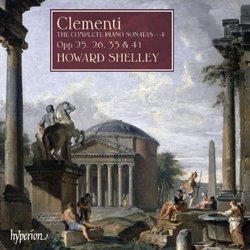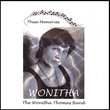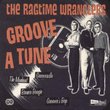| All Artists: Shelley Title: Piano Sonatas 4 Members Wishing: 1 Total Copies: 0 Label: Hyperion Original Release Date: 1/1/2009 Re-Release Date: 10/13/2009 Album Type: Import Genres: New Age, Classical Styles: Instrumental, Historical Periods, Classical (c.1770-1830) Number of Discs: 2 SwapaCD Credits: 2 UPC: 034571177380 |
Search - Shelley :: Piano Sonatas 4
 | Shelley Piano Sonatas 4 Genres: New Age, Classical Howard Shelley's splendid series of Clementi's complete piano sonatas continues with a fourth volume containing some of the composer's most important works. The ten sonatas of Opp. 25, 26, and 33 heard here are all product... more » |
Larger Image |
CD DetailsSynopsis
Product Description Howard Shelley's splendid series of Clementi's complete piano sonatas continues with a fourth volume containing some of the composer's most important works. The ten sonatas of Opp. 25, 26, and 33 heard here are all products of a period in Clementi's life when he was the darling of the London music scene. As well as stunning viruosity, the works recorded here contain a high degree of compositional originality and foward-looking piano writing. The A major sonata (No. 4) has a curiously nineteenth-century sound. The first movement displays a profusion of melodic ornamentation reminiscent of Chopin. The fifth, perhaps Clementi's greatest sonata, was much championed by Horowitz, among others. Similar CDs
|
CD ReviewsThe Stream of Mature Masterworks Begins: For the Tenderfoot, Dace Gisclard | Houston, TX | 10/14/2009 (5 out of 5 stars) "Volume Four of Howard Shelley's Clementi series would be a wise purchase for those who are curious to try a large sample of the best of the sonatas. Here we have eleven, mostly from Clementi's virtuoso career in London in the 1790's. Leon Plantinga, Clementi scholar and author of the album notes, believes that several are transcribed concertos (publishers found that sonatas sold better than concertos). At the very least, SIX of these works can be counted among the composer's finest, for both musical value and pianistic brilliance--Op.25 Nos.1, 4 and 5, and all three of Op.33. Lovers of Beethoven's early sonatas will be bowled over by the athletic grand manner of Op.25 No.1 and Op.33 No.3.
Op.25 is a set of great variety. No.1 is a swashbuckling virtuoso work with brilliant double thirds in both hands, double sixths with their finger-busting quotient boosted by melodic lines in the lower voice, and triple trills. If this wasn't enough to betray the origins of this work as a concerto, the first movement cadenza clinches it. Shelley tosses off its exhausting technical demands with jaw-dropping ease and clarity (as he does with everything else in this series), taking a real Presto for the finale. Op.25 Nos.2 and 3 are conventional but appealing galant works meant for amateurs. If they say nothing new, they are as witty and engaging as Haydn's best sonatas. The first movement of Op.25 No.4 is one of the composer's most startlingly forward-looking conceptions. It is florid and lyrical in a bel canto-ish way, and its highly chromatic melody and harmony presages Chopin and Herz. Its sensual savoring of beautiful sonority for its own sake anticipates Schubert. This is one of four sonatas in the present album that I have performed myself. Although I humbly defer to Mr. Shelley's vastly superior technique and musicality, this movement is the first instance in his series where I prefer my own interpretive ideas. I refer to the "Rossini crescendo" in double sixths that recurs several times. Shelley revs up the tempo for all the occurrences of this passage, although it's not indicated by the composer. I prefer to keep them in tempo, executing a long and very gradual crescendo, building up tension, with the intent of suggesting a "sunrise" effect. I'm not saying Shelley is wrong--his performance is greatly enjoyable. Personally, I prefer to emphasize the relaxed and lyrical (almost Bellinian or Schubertian) qualities of this movement, which thereby offers even greater contrast to the Haydnish finale. However, those who like Shelley's conception will get no argument from me. (An aside--As far as I know, giving nicknames to musical works is not the exclusive privilege of the 18th century, so I'll put forth my own descriptive subtitle for this sonata for consideration--"L'Aurore"--not that I expect it to stick!) Op.25 No.5 is the famous sonata in F-sharp minor popularized by Horowitz. This is Clementi's "Appassionata." Both pianists relish its prophecies of romanticism, applying stylistically appropriate rubato to heighten expressive effect. Passion is alternately contained and released, but stays within a credibly "classical" frame of reference. When preparing my own performance of this sonata, I was both shocked and delighted by Clementi's audacity in his frequent use of melodic augmented seconds--sort of a musical equivalent of an "improper noun" in the 18th century. Op.25 No.6 is again well-behaved and galant, although certainly not bland. It's probably the most absorbing of the three such works in this opus. The slow movement is particularly tuneful and touching--Mozart was wrong about Clementi not having "a farthing's worth of taste or feeling." Op.33 Nos.1 and 2 are bright and witty, but have their darker moments. The writing for the instrument is often more massive than in Clementi's purely "galant" works, and both recall early Beethoven, and, almost as often, Rossini. Op.33 No.3 is another transcribed concerto--the only one of Clementi's to come down to us in an orchestral version. It is equally as grand and demanding as Op.25 No.1. The first movement cadenza is the composer's, and ends in another triple trill. Shelley adds a stylistically appropriate and tastefully brief cadenza to the slow movement, where the composer indicates. Horowitz adds a third cadenza to III, but another cadenza at this point seems like too much of a good thing to me. Clementi doesn't ask for one, and Shelley doesn't supply one. I'm also glad that Shelley doesn't follow Horowitz' lead in trying (unconvincingly) to turn part of the first movement exposition into a slowed-down cadenza(in the manner of the opening of the "Emperor" Concerto?). The British pianist, to my mind, is quite right to keep these passages in tempo. Originally in two movements, the first version of Op.41 is from a much earlier era in the composer's career. Like Spada, Shelley plays the second version of 1804--a radical reworking motivated by Ataria's "pirate" publication. The slow movement, added for this second edition, is one of Clementi's best--a uninterrupted series of ornamental variations on the opening material. In the finale, Clementi tosses about bantering Scarlattian modules, punctuating them here and there with massive proto-Brahmsian chords. I've been looking forward to this particular volume of Shelley's series for a long time, containing, as it does, so many of the composer's best works. Notwithstanding my admittedly subjective reaction to Shelley's Op.25 No.4, I'm absolutely delighted with this set. Other Volumes in this series: Vol.I (Clementi: The Complete Piano Sonatas, Vol. 1); Vol.II (Clementi: The Complete Piano Sonatas, Vol. 2); Vol.III (Piano Sonatas 3) Vol.V Clementi: Piano Sonatas - Vol.5" |





